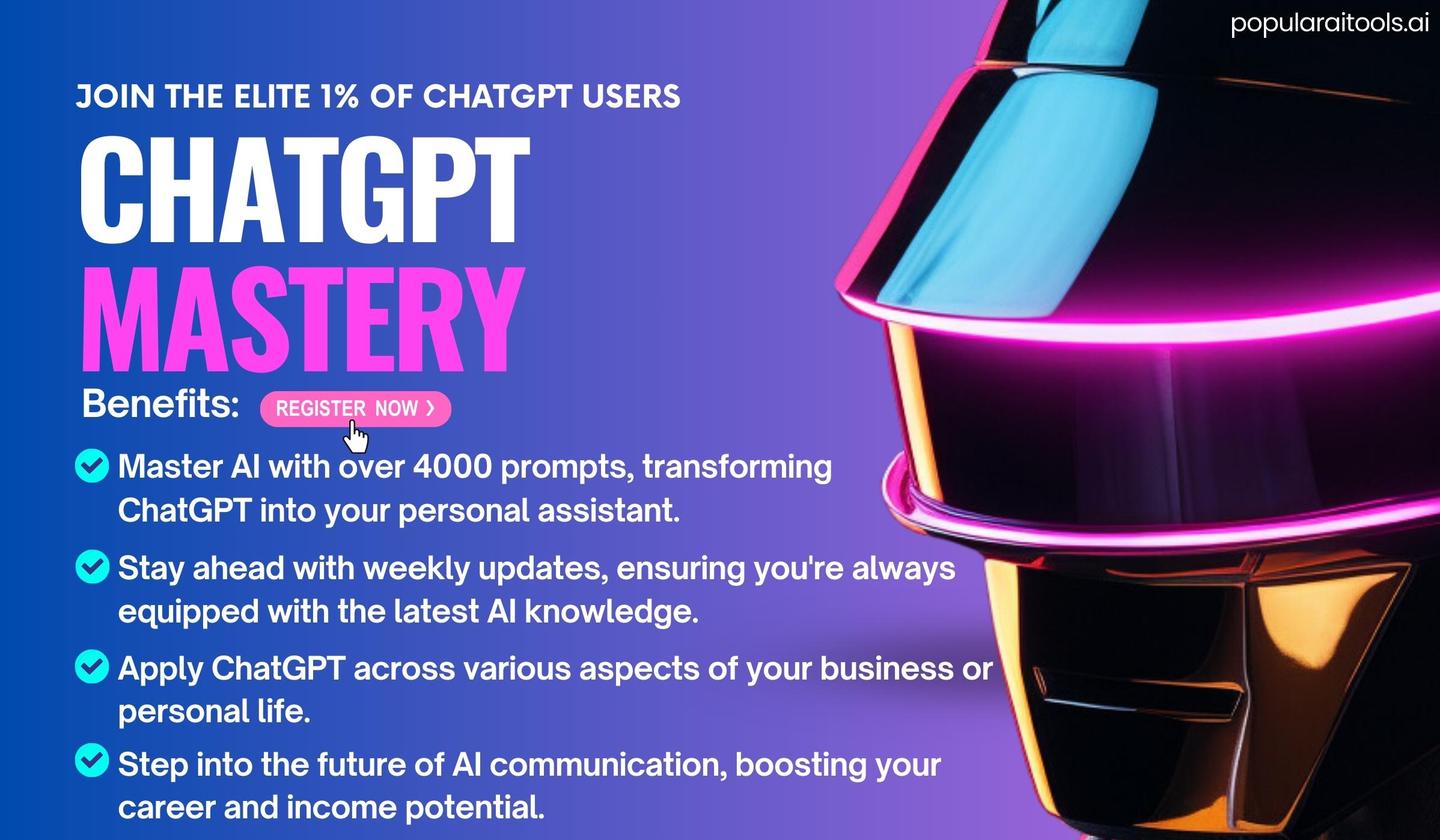Elevate Your ChatGPT Experience: 52 Proven Strategies for Superior Results
Struggling to get the best out of ChatGPT? Want to significantly improve your AI interactions? Our guide offers 52 tested techniques to enhance your ChatGPT output.
Why This Guide Matters
- Learn to craft more effective prompts
- Understand how to guide ChatGPT for better responses
- Discover strategies used by AI experts
What You’ll Gain
- 50% improvement in ChatGPT output quality
- Real-world examples for each strategy
- Actionable tips for immediate implementation
- Insights into large language model capabilities
Key Topics Covered
- Advanced prompt engineering techniques
- Context optimization strategies
- Output refinement methods
- Common pitfalls and how to avoid them
Bonus: Free Cheat Sheet
Access our exclusive cheat sheet with additional techniques to further enhance your ChatGPT interactions.
Whether you’re a ChatGPT novice or an experienced user, this guide offers valuable insights to take your AI conversations to the next level.
Let’s explore how you can unlock ChatGPT’s full potential and transform your AI-assisted tasks.

The Art of Prompting
The effectiveness of these AI models largely depends on the prompts they receive. Crafting the right prompt is an art – one that requires understanding and skill. It’s about asking the right questions in the right way to unlock the full potential of ChatGPT.
Learn How to Prompt Like a Pro and Join The Top 1% Of ChatGPT

Top 52 Tips and Tricks For Better Prompting
Download The Full Cheat Sheet with additional prompt techniques here
Be Direct in Your Prompts: Avoid unnecessary politeness or filler words.
Example: Instead of “Could you please explain climate change?”, use “Explain climate change.”
Audience Specificity: Tailor prompts to the intended audience’s level of understanding.
Example: “Explain quantum physics to a high school student.”
Break Down Complex Tasks: Divide complex prompts into simpler, smaller prompts.
Example: For a complex topic, start with “Define X” followed by “Explain the history of X.”
Use Affirmative Language: Prefer using ‘do’ over ‘don’t’ in instructions.
Example: Say “Do explain both sides of the argument” instead of “Don’t ignore any sides.”
Simplify for Clarity: When clarity is needed, ask to explain in simple terms or to a younger audience.
Example: “Explain the concept of inflation like I’m 10.”
Include Examples: Use example-driven prompting, especially for complex tasks.
Example: “Write a Python function to calculate X. For example, if input is Y, output should be Z.”
Structured Prompts: Begin prompts with ‘###Instruction###’ followed by ‘###Example###’ if needed.
Example: “###Instruction### Explain photosynthesis. ###Example### Light energy is converted to chemical energy.”
Use Specific Phrases for Task Definition: Incorporate phrases like “Your task is”.
Example: “Your task is to provide a summary of the latest AI research trends.”
Incorporate Penalties for Incorrect Responses: Use phrases like “You will be penalized for incorrect answers” to enhance accuracy.
Example: “List the capitals of European countries. You will be penalized for incorrect answers.”
Natural Language Responses: Prompt the model to answer in a human-like manner.
Example: “Answer the following question as if you were explaining to a friend: Why does the moon change shape?”
Use Leading Words: Direct the model’s thought process with leading phrases.
Example: “Think step by step about how a computer works and explain.”
Encourage Unbiased Responses: Add “Ensure that your answer is unbiased.”
Example: “Describe the political system of country X, ensuring your answer is unbiased.”
Engage in Interactive Queries: Let the model ask you questions for clarification.
Example: “I want to learn about space. Ask me questions to gauge my current understanding.”
Educational Prompts with Tests: Ask the model to teach you a concept and test you on it.
Example: “Teach me basic algebra and then give me a few problems to solve.”
Assign Roles to the Model: Give the model a specific role or character to play.
Example: “Pretend you are a fitness coach and give me a workout plan.”
Use Delimiters in Prompts: Structure prompts with clear starting and ending points.
Example: “Start explaining the water cycle. End after discussing precipitation.”
Repeat Key Words: Use repetition within a prompt to emphasize important aspects.
Example: “Explain the importance of, importance of, and importance of biodiversity.”
Combine Methods for Complex Tasks: Use a mix of techniques like Chain-of-Thought with few-shot prompts.
Example: “Explain, step by step, how to solve this algebra problem: [problem].”
Output Primers: End prompts with the beginning of the desired output.
Example: “Create a story about a dragon. Once upon a time…”
Detail-Oriented Writing: When asking for detailed text, explicitly state it.
Example: “Write a detailed summary of the book ‘1984’ by George Orwell.”
Style-Specific Corrections: For text revisions, specify not to change the writing style.
Example: “Correct the grammar in this text without altering its formal tone.”
Complex Coding Prompts: For coding across multiple files, specify the requirement clearly.
Example: “Generate Python code for a multi-file project with a main script and two modules.”
Initiate or Continue Text Using Specific Words: Direct the model to start or continue a piece based on given words.
Example: “Continue this story using the following words: ‘castle’, ‘mystery’, ‘hidden’.”
Explicit Requirements: Clearly state what the model must do or include.
Example: “Write a poem that includes a river, a sunset, and the theme of nostalgia.”
Imitation of Writing Style: Ask the model to mimic the style of a particular author or period.
Example: “Write a short story in the style of Ernest Hemingway.”
Personalized Responses: Request responses that cater to personal preferences or situations.
Example: “Suggest a travel itinerary for someone who loves history and nature.”
Historical or Fictional Scenarios: Direct the model to provide responses in the context of a historical period or fictional world.
Example: “Describe a day in the life of a Roman soldier.”
Multilingual Prompts: Ask the model to respond in a specific language.
Example: “Explain the benefits of renewable energy in Spanish.”
Creative Challenges: Encourage creative thinking with challenging prompts.
Example: “Invent a sport that could be played on Mars and describe the rules.”
Ethical Boundaries: Clearly state ethical limits in prompts.
Example: “Provide a solution for reducing waste, ensuring it is environmentally friendly and ethical.”
Feedback Requests: Ask for feedback on a given idea or creation.
Example: “Review this short story draft and suggest improvements.”
Balanced Perspective: Request a balanced view on controversial topics.
Example: “Present both sides of the debate on genetic modification of crops.”
Factual Accuracy Emphasis: Emphasize the need for accuracy in responses.
Example: “List the latest statistics on climate change, ensuring all data is up-to-date and accurate.”
Problem-Solving Approaches: Direct the model to solve a problem step-by-step.
Example: “Step by step, how would you resolve a conflict between team members?”
Local Context: Include local or cultural context in prompts.
Example: “Explain the significance of the Diwali festival in Indian culture.”
Real-Time Updates: Ask for the most recent information or developments.
Example: “What are the latest advancements in AI as of 2024?”
Contrasting Views: Request contrasting viewpoints for a comprehensive understanding.
Example: “Compare capitalist and socialist economic models.”
Predictive Analysis: Ask for predictions based on current trends or data.
Example: “Predict the future of renewable energy sources in the next decade.”
Speculative Scenarios: Engage in ‘what if’ scenarios for creative exploration.
Example: “What if the internet was never invented? Describe the impact on society.”
Comparative Analysis: Request a comparison between two or more items.
Example: “Compare the health benefits of yoga and regular gym workouts.”
Exploratory Questions: Encourage exploration and curiosity in responses.
Example: “Explore the potential of quantum computing in medicine.”
Logical Reasoning: Prompt the model to use logical reasoning in its response.
Example: “Using logic, argue for the importance of education in developing countries.”
Crisis Management: Simulate crisis situations for problem-solving exercises.
Example: “How would you handle a major cybersecurity breach in a company?”
Cultural Sensitivity: Ensure prompts are culturally sensitive and inclusive.
Example: “Discuss the significance of family in different cultures around the world.”
Time-Bound Tasks: Set a time frame for the completion of tasks in the prompt.
Example: “Outline a 30-day plan to improve personal fitness.”
Reflective Questions: Encourage self-reflection or perspective-taking.
Example: “Reflect on the impact of social media on your daily life.”
Collaborative Scenarios: Promote collaboration in responses.
Example: “Design a collaborative project for students from different disciplines.”
Humorous Tone: Request responses with a light-hearted or humorous tone.
Example: “Tell a funny story about a day in the life of a cat.”
Poetic Responses: Ask for responses in poetic or lyrical form.
Example: “Describe a sunset in a poetic manner.”
Empathy and Emotion: Direct the model to show empathy or emotion in its responses.
Example: “Express the feelings of a person visiting their hometown after many years.”
Learn How to Prompt Like a Pro and Join The Top 1% Of ChatGPT

Principles of Effective Prompting
Breaking Down the PrinciplesUnderstanding these principles is key to mastering ChatGPT. Each principle has its unique role, and applying them requires a blend of knowledge and creativity. We’ll explore these principles with practical examples, showing how they can be implemented in everyday use.
Five Key Categories
- Structure: A well-structured prompt leads to clear and organized responses. It’s about setting the right framework for your query.
- Clarity: The clearer the question, the better the response. Avoid ambiguities and be direct in your requests.
- Specificity: General questions lead to general answers. Specificity in prompts can significantly enhance the relevance and depth of the responses.
- User Interaction: Engaging with ChatGPT is a two-way street. The way you interact with the model can influence the quality of its output.
- Content: The substance of your prompt matters. Focusing on meaningful and relevant content yields more insightful responses.

Improving Clarity and Understanding
Strategies for Clear Prompts
- Simplicity: Use straightforward language for clarity.
- Focus: Concentrate on one topic or question at a time.
Techniques for Tailored Explanations
- Age-Appropriate Language: Adjust complexity for younger audiences.
- Beginner-Level Approach: Simplify terms for newcomers in a field.
Text Replication and Modification
Mimicking Text Style
- Analysis: Understand the style of the sample text.
- Application: Use similar vocabulary and sentence structure.
Style-Consistent Modification
- Retention: Keep the original style intact.
- Enhancement: Improve grammar and vocabulary without altering the style.

Directive Language and Structuring Prompts
Importance of Directive Language
- Clear Instructions: Directly state your expectations.
- Firmness: Use definitive language for better compliance.
Effective Prompt Structuring
- Logical Flow: Organize your prompt coherently.
- Specificity: Detail the task clearly to avoid ambiguity.
Frequently Asked Questions
What are the best ChatGPT prompts for beginners?
The best ChatGPT prompts for beginners are those that are simple, clear, and direct. Beginners should start with basic queries like, “Explain the basics of climate change,” or “Define the term ‘artificial intelligence’.” These prompts should be straightforward to avoid confusion and help the user understand how ChatGPT processes and responds to queries. According to the article, simplicity and clarity in prompts ensure more accurate and relevant responses from AI models.
How can I master the best ChatGPT prompting technique?
Mastering the best ChatGPT prompting technique involves understanding the AI’s capabilities and limitations. It’s crucial to practice crafting clear, concise, and specific prompts. The article suggests using structured prompts and being explicit about the desired outcome. For instance, instead of saying, “Tell me about AI,” say, “Explain three impacts of AI in healthcare.” This specificity guides the AI to provide focused and comprehensive responses.
What’s the secret to prompt like a pro with ChatGPT?
Prompting like a pro with ChatGPT means knowing how to elicit the most informative, relevant, and accurate responses. According to the article, this involves using affirmative language, being direct, and avoiding unnecessary politeness or filler words. It also involves structuring your prompts to be clear and to the point. For example, instead of asking, “I was wondering if you could tell me about the history of the internet?” use “Explain the history of the internet.”
Can you give examples of advanced ChatGPT prompts?
Advanced ChatGPT prompts typically involve complex, multi-layered questions that require the AI to demonstrate a deeper level of reasoning or creativity. An example of an advanced prompt, as suggested in the article, could be, “Outline a plan for a small business to increase online sales over the next six months, considering current market trends.” This prompt requires the AI to consider multiple variables and provide a detailed response.
What makes a ChatGPT prompt effective?
An effective ChatGPT prompt is one that is clearly structured, concise, and precise in what it asks. Effectiveness in prompting is enhanced by the use of specific phrases that guide the AI towards the desired task, as indicated in the article. For example, using “Your task is to…” or “Explain in detail…” helps in generating more focused and comprehensive responses from ChatGPT.
How do I create ChatGPT prompts for complex topics?
Creating prompts for complex topics involves breaking down the topic into more manageable sub-questions or focusing on specific aspects of the topic. The article advises using a step-by-step approach for complex queries. For example, if you want to understand a complex scientific theory, start with “Define X theory,” followed by “Explain the main principles of X theory.”
What are common mistakes in crafting ChatGPT prompts?
Common mistakes in crafting ChatGPT prompts include being too vague, using overly complex language, or being excessively polite, which can lead to ambiguous or unhelpful responses. The article emphasizes the importance of direct and clear language. For example, instead of saying, “If it’s not too much trouble, could you possibly give me some information on…” use “Provide information on…”
How do I ensure my ChatGPT prompts are unbiased?
To ensure that your ChatGPT prompts are unbiased, you should frame questions in a neutral manner and avoid leading language. The article suggests adding qualifiers like “Ensure that your answer is unbiased” to prompt the model to avoid biases. For example, “Describe the political system of country X, ensuring your answer is unbiased.”
Can I use ChatGPT for creative writing prompts?
Yes, ChatGPT can be effectively used for creative writing prompts. It can generate ideas, continue storylines, or help with character development. The article highlights the AI’s capability to assist in creative tasks when given specific directions. For instance, you might say, “Write a short story about a lost astronaut on Mars,” to prompt a creative narrative.
What are the best practices for educational prompts in ChatGPT?
For educational prompts, it’s best to be clear about the learning objective and ensure that the complexity of the prompt matches the educational level of the intended audience. The article suggests tailoring prompts to be age-appropriate and focusing on specific learning outcomes. For example, “Explain the concept of photosynthesis to a 10-year-old.”
How can I use ChatGPT for business-related prompts?
For business-related prompts, focus on specific aspects of business, such as marketing strategies, product development, or customer service improvements. The article advises using industry-specific terminology and framing prompts in a way that relates directly to business outcomes. For example, “Suggest three strategies for improving customer engagement in an online retail business.”
What is the best way to get detailed responses from ChatGPT?
To get detailed responses from ChatGPT, you should ask comprehensive questions and specify that you want an in-depth answer. According to the article, using phrases like “Explain in detail” or “Provide a comprehensive overview” can guide the AI to deliver more elaborate responses. For instance, “Provide a detailed analysis of the current trends in renewable energy.”
How do I prompt ChatGPT for technical explanations?
When seeking technical explanations, it’s important to use specific technical terms and ask for a step-by-step breakdown of concepts. The article emphasizes the importance of clarity and specificity in technical prompts. For example, “Explain how machine learning algorithms work, step by step.”
What’s the best way to refine my ChatGPT prompting skills?
Refining your ChatGPT prompting skills involves practice and analysis. Experiment with different types of prompts and analyze the AI’s responses to understand what works best. The article suggests that learning from successful prompts and adjusting based on AI responses is key to skill refinement.
Can ChatGPT prompts be used for professional development?
ChatGPT prompts can indeed be used for professional development. They can provide industry insights, suggest learning resources, and offer career advice. The article notes that prompts focused on specific professional skills or industry knowledge can be particularly beneficial.
How do I use ChatGPT for problem-solving prompts?
For problem-solving prompts, present a clear problem statement and ask for a step-by-step solution. The article advises breaking down the problem into smaller components and asking the AI to address each part individually for more effective problem-solving.
What are some innovative uses of ChatGPT prompts?
Innovative uses of ChatGPT prompts include language learning assistance, creating personalized workout or diet plans, and generating unique business ideas. The article highlights the AI’s versatility in handling a wide range of creative and practical tasks.
How can I use ChatGPT to improve my writing skills?
ChatGPT can be used to critique your writing, provide grammar and style tips, and even help with structuring content. The article suggests using prompts that ask for specific feedback on your writing or prompts that request examples of well-written content in your desired style.
What are the limitations of ChatGPT prompts?
The limitations of ChatGPT prompts include the AI’s reliance on its training data and inability to provide real-world experience or insights. The article mentions that understanding these limitations is crucial for setting realistic expectations about the AI’s capabilities.
How do I use ChatGPT for personal growth prompts?
For personal growth prompts, ask ChatGPT for advice on topics like time management, goal setting, and self-reflection exercises. The article points out that AI can offer a variety of perspectives and suggestions that can be tailored to personal development needs.

